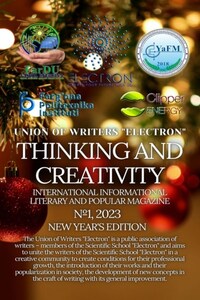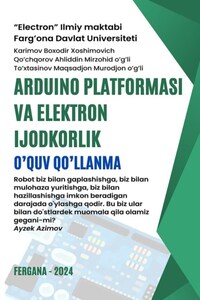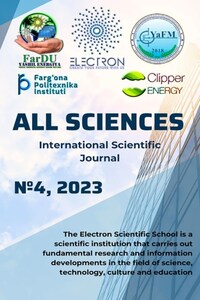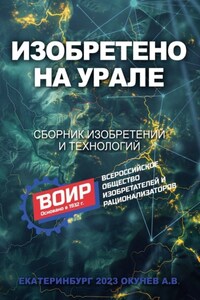Editor Ibratjon Xatamovich Aliyev
Editor Boxodir Xoshimovich Karimov
Editor Farruh Murodjonovich Sharofutdinov
Editor Sultonali Mukaramovich Abduraxmonov
Editor Botirali Rustamovich Jalolov
Cover design Ibratjon Xatamovich Aliyev
Cover design Boxodir Xoshimovich Karimov
Illustrator Ibratjon Xatamovich Aliyev
Illustrator Boxodir Xoshimovich Karimov
Proofreader Salim Madraximovich Otajonov
Reviewer, Doctor of Technical Sciences, Professor of the Research Institute "Physics of Semiconductors and Microelectronics" at the National University of the Republic of Uzbekistan Obbozjon Xoshimovich Qo'ldoshev
Reviewer, Senior Researcher, Head of the Accelerator Center at the Research Institute "Physics of Semiconductors and Microelectronics" at the National University of the Republic of Uzbekistan Rinad Fuadovich Rumi
Reviewer, Doctor of Physical and Mathematical Sciences, Professor and Chief Researcher of the "Institute of Nuclear Physics" of the Republic of Uzbekistan Sergey Viktorovich Artyomov
Reviewer, Candidate of Physical and Mathematical Sciences, Associate Professor of the Department of "Electronics and Instrumentation" of the Faculty of Computer Design Systems of the Fergana Polytechnic Institute Sultonali Rustamovich Abduraxmonov
Reviewer, Candidate of Economic Sciences, Associate Professor of the Fergana Polytechnic Institute Foziljon Oripovich Obidov
© Ibratjon Xatamovich Aliyev, 2023
© Boxodir Xoshimovich Karimov, 2023
© Botirali Rustamovich Jalolov, 2023
ISBN 978-5-0059-4541-9
Created with Ridero smart publishing system
If you are doing something beautiful and sublime, and no one notices it – do not worry: sunrise is generally the most beautiful sight in the world, but most people are still asleep at this time.
John Lennon
Energy is what characterizes the entire civilization and this is an extremely true statement, because even the level of development of society is determined precisely due to the amount of energy generated by it. But this generation may not always be safe. For example, the generation of electrical energy through steam is extremely complex, and in large volumes even dangerous technology that leads to large-scale natural disasters. Speaking of the wind industry, it has yet to be studied in more detail, but if we stop at nuclear energy, it is important to say that uranium is already outliving its age and it is necessary to switch to more advanced technologies, for example, the inclusion of thermonuclear reactions, but even better the use of resonant nuclear reactions, which have been mentioned more than once and it was said.
By themselves, these reactions are as environmentally friendly as solar energy, of course, with the introduction of some very revolutionary changes. But even more shocking will be the collaboration of these two titans of the energy industry – solar energy and energy of resonant nuclear reactions, which is likely to give just a shocking result. Speaking about the relevance and relevance of this project as such, it is enough just to note the beginning of the "energy hunger" across the planet and around the world.
But if we stop only at the technologies of solar power plants themselves, then we can already cite a number of very different facts regarding the active development of this direction as quite rapidly progressing.
Speaking about the study of this problem, it is important to proceed from the very beginning. The first discovery in 1839 by Alexander Edmond Becquerel of the photoelectric effect in the study of electrolytic elements contributed to the growth of interest in them among the scientific community. In 1873, Willoughby Smith discovered the photoconductivity of selenium, and in Johann Elster and Hans Geitel studied the effects of sunlight on electrified bodies. Later in 1887, Heinrich Hertz observed the photoelectric effect and reported on the production and reception of electromagnetic waves with their help.
In the future, this issue most often turned to scientific debates, but for the first time the idea of industrial use of solar energy is assigned to the time of Frank Schumann, on the use of solar engines and pumping water with their help. But for his project, about 15,000 square meters of Land were needed to use solar generators resembling modern solar collectors, which would allow for 1,000 horsepower. And for the first time experimentally, this project began its work on the territory of Africa back in June 1913.
After that, the German government, headed by Wilhelm II himself, allocated large sums for this, but the First World War began, which contributed to the closure of the project.
Speaking of the scientific development of the idea, further study of this issue in the effects of Stoletov, Riga, Hoor and others led to a number of questions and later developed into the famous "absolutely black body" problem, near the 1900s. Which was later solved thanks to the introduction of Max Planck's works in the work "On the law of energy distribution in the normal spectrum", which was finally boldly developed in a completely different way, having received the simplest and at the same time ingenious solution by Albert Einstein, in the form of his equation for the photoelectric effect, for which he was awarded the Nobel Prize in 1921. awards.












